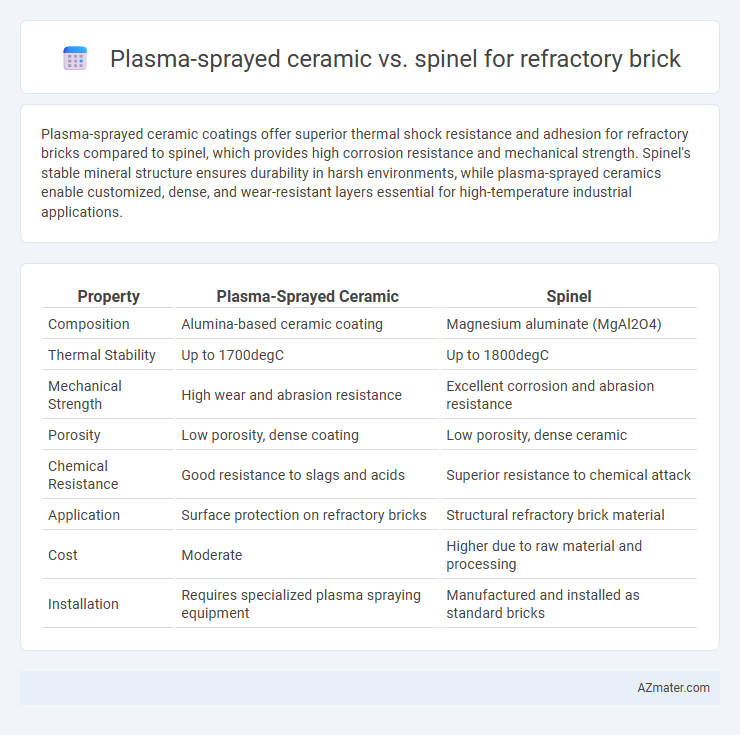Plasma-sprayed ceramic coatings offer superior thermal shock resistance and adhesion for refractory bricks compared to spinel, which provides high corrosion resistance and mechanical strength. Spinel's stable mineral structure ensures durability in harsh environments, while plasma-sprayed ceramics enable customized, dense, and wear-resistant layers essential for high-temperature industrial applications.
Table of Comparison
| Property | Plasma-Sprayed Ceramic | Spinel |
|---|---|---|
| Composition | Alumina-based ceramic coating | Magnesium aluminate (MgAl2O4) |
| Thermal Stability | Up to 1700degC | Up to 1800degC |
| Mechanical Strength | High wear and abrasion resistance | Excellent corrosion and abrasion resistance |
| Porosity | Low porosity, dense coating | Low porosity, dense ceramic |
| Chemical Resistance | Good resistance to slags and acids | Superior resistance to chemical attack |
| Application | Surface protection on refractory bricks | Structural refractory brick material |
| Cost | Moderate | Higher due to raw material and processing |
| Installation | Requires specialized plasma spraying equipment | Manufactured and installed as standard bricks |
Comparative Overview: Plasma-Sprayed Ceramic vs Spinel Refractory Bricks
Plasma-sprayed ceramic refractory bricks exhibit superior thermal shock resistance and a denser microstructure compared to spinel bricks, enhancing durability in high-temperature environments. Spinel refractory bricks, composed primarily of magnesium aluminate, offer excellent chemical stability and corrosion resistance, particularly against slag and acidic conditions. The selection between plasma-sprayed ceramic and spinel bricks depends on operational requirements, with plasma-sprayed ceramics favored for applications requiring rapid heat cycling and spinel bricks preferred for aggressive chemical exposures.
Material Composition and Microstructural Differences
Plasma-sprayed ceramic refractory bricks predominantly consist of alumina or zirconia-based compounds, exhibiting a dense, layered microstructure formed by rapid solidification of molten particles. Spinel refractories are composed of magnesium aluminate (MgAl2O4) with a crystalline microstructure characterized by interlocking grains, which enhance thermal shock resistance and mechanical strength. The key difference lies in plasma-sprayed ceramics' dense, lamellar microstructure versus spinel's robust crystalline microstructure, influencing their respective thermal and wear properties.
Thermal Resistance and Conductivity Analysis
Plasma-sprayed ceramic coatings exhibit superior thermal resistance due to their dense microstructure and low porosity, which effectively minimizes heat penetration in refractory bricks. In contrast, spinel-based refractories offer a balanced thermal conductivity, providing moderate heat dissipation while maintaining structural integrity under high-temperature conditions. Thermal conductivity analysis reveals plasma-sprayed ceramics typically have lower conductivity values (~1.0-1.5 W/m*K) compared to spinel bricks (~3.0-4.5 W/m*K), making plasma-sprayed ceramics more efficient for insulation purposes in high-temperature industrial applications.
Mechanical Strength and Wear Performance
Plasma-sprayed ceramic coatings exhibit superior mechanical strength due to their dense microstructure and strong adhesion to substrates, making them highly resistant to impact and thermal stresses in refractory bricks. Spinel, a magnesium aluminate ceramic, offers excellent wear performance through high hardness and chemical stability, ensuring prolonged durability in abrasive environments. When comparing both, plasma-sprayed ceramics typically outperform spinel in mechanical strength, while spinel demonstrates enhanced wear resistance under high-temperature oxidative conditions.
Corrosion and Chemical Attack Resistance
Plasma-sprayed ceramic coatings provide enhanced corrosion and chemical attack resistance due to their dense microstructure and strong adhesion, effectively protecting refractory bricks from aggressive slags and molten metals in harsh industrial environments. Spinel, a magnesium aluminate mineral, offers excellent chemical stability and resistance to acidic and basic slags, but may suffer from phase transformations that reduce durability under extreme thermal cycling. Comparing both, plasma-sprayed ceramics generally deliver superior protective performance against corrosive agents, whereas spinel bricks offer inherent material stability with moderate resistance under fluctuating conditions.
Installation Techniques and Process Efficiency
Plasma-sprayed ceramic coatings exhibit superior adhesion and uniformity due to the high-velocity thermal spraying process, enabling faster installation with minimal surface preparation compared to traditional cast and pressed spinel refractory bricks. Spinel refractory bricks require precise alignment and mortar application during installation, often lengthening the process and necessitating skilled labor to ensure optimal performance and durability. The plasma spraying technique reduces downtime and enhances process efficiency by allowing in-situ repair and coating, whereas spinel bricks involve longer curing times and higher labor costs, impacting operational continuity.
Lifespan and Maintenance Requirements
Plasma-sprayed ceramic coatings offer enhanced lifespan for refractory bricks due to their superior adhesion and dense microstructure, which resists thermal shock and erosion more effectively than Spinel-based bricks. Spinel refractory bricks, while chemically stable and resistant to slag penetration, typically require more frequent maintenance and replacement because their crystalline structure is more prone to microcracking under extreme thermal cycling. Choosing plasma-sprayed ceramics reduces overall maintenance needs and downtime, providing a cost-efficient solution for high-temperature industrial applications.
Cost Analysis: Production and Operational Expenses
Plasma-sprayed ceramic refractory bricks generally incur higher production costs due to specialized equipment and energy-intensive processes compared to Spinel bricks, which are manufactured via conventional sintering methods. Operational expenses for plasma-sprayed ceramics can be lower over time, benefiting from superior thermal shock resistance and longer service life that reduce maintenance and replacement frequency. Spinel refractories, while cheaper upfront, may demand more frequent repairs and have higher wear rates, affecting overall cost efficiency in high-temperature industrial applications.
Suitability for High-Temperature Applications
Plasma-sprayed ceramic coatings provide excellent thermal barrier properties and resistance to high temperatures exceeding 1500degC, making them highly suitable for refractory brick applications in extreme environments. Spinel, with its superior chemical stability and resistance to thermal shock up to 1600degC, offers enhanced durability and structural integrity in refractory linings exposed to rapid temperature fluctuations. Both materials excel in high-temperature settings, but plasma-sprayed ceramics offer more precise control over coating thickness and microstructure, optimizing performance under prolonged thermal stress.
Industry Applications: Selecting the Optimal Refractory Material
Plasma-sprayed ceramic coatings offer exceptional thermal resistance and wear protection, making them ideal for high-temperature industrial applications like gas turbines, boilers, and furnaces. Spinel refractory bricks provide superior chemical stability and resistance to slag penetration, which is critical in steelmaking, cement production, and glass manufacturing. Choosing between plasma-sprayed ceramics and spinel bricks depends on specific operational demands such as exposure to corrosive environments or thermal shock resistance within industries.

Infographic: Plasma-sprayed ceramic vs Spinel for Refractory brick
 azmater.com
azmater.com